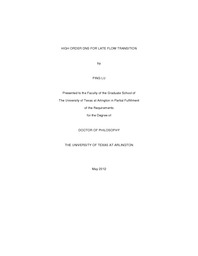
ATTENTION: The works hosted here are being migrated to a new repository that will consolidate resources, improve discoverability, and better show UTA's research impact on the global community. We will update authors as the migration progresses. Please see MavMatrix for more information.
Show simple item record
| dc.contributor.author | Lu, Ping | en_US |
| dc.date.accessioned | 2012-07-25T19:09:38Z | |
| dc.date.available | 2012-07-25T19:09:38Z | |
| dc.date.issued | 2012-07-25 | |
| dc.date.submitted | January 2012 | en_US |
| dc.identifier.other | DISS-11618 | en_US |
| dc.identifier.uri | http://hdl.handle.net/10106/11094 | |
| dc.description.abstract | In this report, a new high order scheme for boundary points is introduced when calculating the derivative of smooth functions by Compact Scheme. The primitive function reconstruction method of ENO schemes is applied to obtain the conservative form of the Compact Scheme. Meanwhile, modified compact scheme is developed by using an effective shock detector to block upwinding compact scheme to cross the shock, a control function, and an adaptive scheme which uses some WENO flux near the shock. The new scheme makes the original upwinding compact scheme able to capture the shock sharper than WENO and, more important, keep high order accuracy and high resolution in the smooth area which is particularly important for shock, shock boundary layer interaction and shock acoustic interaction.This report is also devoted to a DNS study of late nonlinear stages of laminar-turbulent transition on a flat plate. A number of new mechanisms about turbulence generation are presented as following. It includes mechanism of the large coherent vortex structure formation, small length scale generation and flow randomization, etc. It is shown that the energy transfer from large vortices to small vortices is carried out by multiple level sweeps, and all small length scales (turbulence) are generated by shear layer instability which is produced by large vortex structure with multiple level vortex rings, multiple level sweeps, and multiple level positive spikes near the laminar sub-layers. Also, it reveals that multiple vortex rings are also consequences of shear layer instability produced by momentum deficit which is formed by vortex ejections. In additional, the U-shaped vortex, which is not a secondary but tertiary vortex, serves as an additional channel to support the multiple ring structure. It is found that the loss of symmetry and randomization are caused by internal property of the boundary layer. Moreover, the loss of symmetry starts from the second level ring cycle in the middle of the flow field and spreads to the bottom of the boundary layer and then the whole flow field. More other new mechanisms have been discussed as well. | en_US |
| dc.description.sponsorship | Liu, Chaoqun | en_US |
| dc.language.iso | en | en_US |
| dc.publisher | Mathematics | en_US |
| dc.title | High Order DNS For Late Flow Transition | en_US |
| dc.type | Ph.D. | en_US |
| dc.contributor.committeeChair | Liu, Chaoqun | en_US |
| dc.degree.department | Mathematics | en_US |
| dc.degree.discipline | Mathematics | en_US |
| dc.degree.grantor | University of Texas at Arlington | en_US |
| dc.degree.level | doctoral | en_US |
| dc.degree.name | Ph.D. | en_US |
Files in this item
- Name:
- Lu_uta_2502D_11618.pdf
- Size:
- 24.95Mb
- Format:
- PDF
This item appears in the following Collection(s)
Show simple item record


